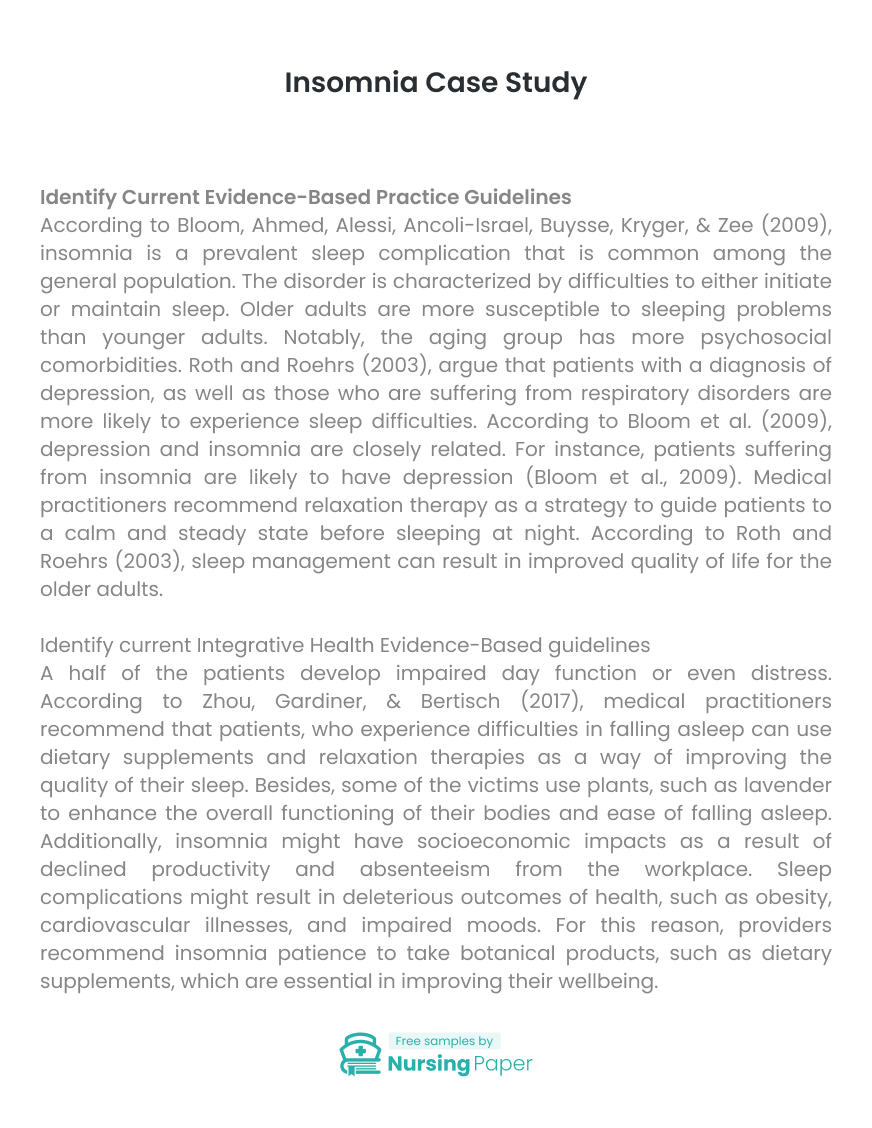
Identify Current Evidence-Based Practice Guidelines
According to Bloom, Ahmed, Alessi, Ancoli-Israel, Buysse, Kryger, & Zee (2009), insomnia is a prevalent sleep complication that is common among the general population. The disorder is characterized by difficulties to either initiate or maintain sleep. Older adults are more susceptible to sleeping problems than younger adults. Notably, the aging group has more psychosocial comorbidities. Roth and Roehrs (2003), argue that patients with a diagnosis of depression, as well as those who are suffering from respiratory disorders are more likely to experience sleep difficulties. According to Bloom et al. (2009), depression and insomnia are closely related. For instance, patients suffering from insomnia are likely to have depression (Bloom et al., 2009). Medical practitioners recommend relaxation therapy as a strategy to guide patients to a calm and steady state before sleeping at night. According to Roth and Roehrs (2003), sleep management can result in improved quality of life for the older adults.
Identify Current Integrative Health Evidence-Based Guidelines
A half of the patients develop impaired day function or even distress. According to Zhou, Gardiner, & Bertisch (2017), medical practitioners recommend that patients, who experience difficulties in falling asleep can use dietary supplements and relaxation therapies as a way of improving the quality of their sleep. Besides, some of the victims use plants, such as lavender to enhance the overall functioning of their bodies and ease of falling asleep. Additionally, insomnia might have socioeconomic impacts as a result of declined productivity and absenteeism from the workplace. Sleep complications might result in deleterious outcomes of health, such as obesity, cardiovascular illnesses, and impaired moods. For this reason, providers recommend insomnia patience to take botanical products, such as dietary supplements, which are essential in improving their wellbeing.


Identify Metis Based Practice Experience
As a nurse, I had an opportunity to interact with patients suffering from insomnia. They reported on unsatisfactory quality and quantity of sleep as a result of difficulties to either fall or maintain sleep. I realized that approximately 50 percent of both male and female elderly groups’ experience sleep difficulties. The distress symptoms results in social and occupational impairment among the victims (Roth and Roehrs, 2003). I recommended for sleep hygiene and cognitive strategies as the first line forms of treatment, especially at the primary care level. However, the victims can use medications in extreme cases.
Identify the Brand, Dosages, Preparation, Etc. To Help Answer the Case
According to Cloos and Ferreira (2009), health care providers recommend that patients should take 10-15 mgs of benzodiazepines for three times in a day, as a medication to treat insomnia. However, patients can only take the drug for short-term use. Notably, benzodiazepines are effective in promoting the total sleep duration. Oxazepam is one of the common types of benzodiazepines that are used to treat sleep disorder and anxiety (Roth and Roehrs, 2003). Adults should take 5-15 mg of Oxazepam daily. However, doctors might recommend for an increase of the dosage to about 80 mg if patients do not respond to the drugs. Physicians endorse that children under the age of 16 years should take 5mg of Oxazepam on daily basis (Roth and Roehrs, 2003). The drug is available either in the form of capsules or tablets. Notably, patients having side effects in their digestive tract can consume the drug with food. Most importantly, sleep disorders victims should avoid stimulants such as caffeinated drinks before bedtime. Besides, the patients should ensure that they have enough time to relax before bedtime to reduce the level of anxiety.
What Would You Recommend to a Patient?
As a nurse practitioner, I would recommend insomnia patients to use 5-15 mgs of Oxazepam on daily basis to reduce their sleep anxiety. However, the patients must inform the pharmacists, nurses, and doctors about the drugs they are taking. In conclusion, I would recommend patients to take part in regular physical exercises, maintain a healthy diet, and avoid the use of stimulants from a holistic approach.

1. Bloom, H. G., Ahmed, I., Alessi, C. A., Ancoli‐Israel, S., Buysse, D. J., Kryger, M. H, & Zee, P. C. (2009). Evidence‐based recommendations for the assessment and management of sleep disorders in older persons. Journal of the American Geriatrics Society, 57(5), 761-789.
2. Cloos, J. M., & Ferreira, V. (2009). Current use of benzodiazepines in anxiety disorders. Current Opinion in Psychiatry, 22(1), 90-95.
3. Roth, T., & Roehrs, T. (2003). Insomnia: epidemiology, characteristics, and consequences. Clinical cornerstone, 5(3), 5-15.



The download will start shortly.

The download will start shortly.
 Subject:
Health and Social Care
Subject:
Health and Social Care  Number of pages: 5
Number of pages: 5  Subject:
Nursing
Subject:
Nursing  Number of pages: 3
Number of pages: 3  Subject:
Nursing
Subject:
Nursing  Number of pages: 5
Number of pages: 5  Subject:
Nursing
Subject:
Nursing  Number of pages: 4
Number of pages: 4  Subject:
Health and Social Care
Subject:
Health and Social Care  Number of pages: 4
Number of pages: 4  Subject:
Health and Social Care
Subject:
Health and Social Care  Number of pages: 4
Number of pages: 4  Subject:
Health and Social Care
Subject:
Health and Social Care  Number of pages: 3
Number of pages: 3  Subject:
Nursing
Subject:
Nursing  Number of pages: 2
Number of pages: 2  Subject:
Health and Social Care
Subject:
Health and Social Care  Number of pages: 2
Number of pages: 2  Subject:
Health and Social Care
Subject:
Health and Social Care  Number of pages: 2
Number of pages: 2  Subject:
Nursing
Subject:
Nursing  Number of pages: 3
Number of pages: 3  Subject:
Medicine
Subject:
Medicine  Number of pages: 5
Number of pages: 5  Subject:
Nursing
Subject:
Nursing  Number of pages: 8
Number of pages: 8  Subject:
Nursing
Subject:
Nursing  Number of pages: 3
Number of pages: 3  Subject:
Medicine
Subject:
Medicine  Number of pages: 6
Number of pages: 6 
